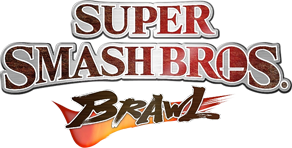
Introduction
Super Smash Bros. Brawl is the highly-anticipated third installment to Nintendo's popular Super Smash Bros. Series. It adds a few new characters to the roster including third parties such as Snake and Sonic, while dumping a few old ones. This game features a lot of new content, such as a large-scale story mode called the Subspace Emmisary and lots of collectibles including trophies, stickers and CDs. It also has one of the largest music libraries in any videogame, featuring original versions and new arrangements of famous songs throughout Nintendo history rearranged by 38 renowned video game composers. However, it has been criticised by a lot of competitive players due to it's slower engine, drastically reduced hitstun, removal of useful advanced techniques, unbalanced gameplay, mediocre online capabilities, cheap techniques like chaingrabs and tripping.
Controls and Terminology
There are tons of different terms used in Smash to describe the plethora of techniques that it can be confusing even for experienced players. Here you will not only read about the controls but the terminology used by Smash players.
System Guide
This guide shall tell you how everything in Super Smash Bros. Brawl works. Every technical aspect will be discusses in this portion of the guide.
Basic Elements
This section covers the most basic elements of Brawl that you may also find in other fighting games.
- Basic Rules
- Percentage Counter
- Timer
- Stocks
- Coin Counter
- Versus Mode Variables
- Team Battle
Universal Abilities
These are the abilities shared by every character in the game. These include the following:
- Basic Movement
- Shielding
- Perfect Shielding
- Dodging
- Standard Attacks
- Special Attacks
- Wakeup and Recovery
- Grabbing and Throws
- Teching
- Directional Influence
- Taunting
- Item Usage
- Final Smash
Game Systems
This section covers the rules and physics of Brawl.
- Hitstun and Hitlag
- Super Armor
- Invincibility
Characters
Stages
Stages are a unique feature in the Smash series as they're not only a change in scenery, but they also affect the game play during a match.
General
Starter
These are the basic stages used for tournament play.
- Battlefield
- Castle Siege
- Final Destruction
- Lylat Cruise
- Pokémon Stadium (Melee)
- Smashville
- Yoshi's Island
Counterpick
This category includes basic tournament stages that are often chosen to gain and advantage over the opponent's character.
- Brinstar (Melee)
- Delfino Plaza
- Frigate Orpheon
- Halberd
- Pokemon Stadium 2
- Rainbow Cruise (Melee)
Banned
The banned list of stages are those that you likely not see in a tournament.
- 75m
- Big Blue (Melee)
- Bridge of Eldin
- Corneria (Melee)
- Distant Planet
- Flat Zone 2
- Green Greens (Melee)
- Green Hill Zone
- Hanenbow
- Jungle Japes (Melee)
- Luigi's Mansion
- Mario Bros.
- Mario Circuit
- Mushroomy Kingdom
- New Pork City
- Norfair
- Onett (Melee)
- Pictochat
- Pirate Ship
- Port Town Aero Dive
- Rumble Falls
- Shadow Moses Island
- Skyworld
- Spear Pillar
- Summit
- Temple (Melee)
- WarioWare, Inc.
- Yoshi's Island (Melee)
Items
Items are another unique feature in the Smash series, but they are always turned off in competitive play, so this guide won't cover items. The only exception will be items that are spawned by special moves like Diddy Kong's Banana Peel or Peach's Vegetable picking up Beam Swords or Bomb-ombs.
Tournament Ruleset
Due to it's chaotic and highly random gameplay, it's difficult to play Smash competitively without stripping most of the variables in the game. This is where the Brawl Back Room comes in, composed of the best and most contributive Brawl players and organizers of the biggest tournaments to discuss rulesets and stage legality, create tier lists and making matchup tables. This section will provide the rulesets and stagelists that are widely used.
- Japanese Ruleset This is the most used ruleset in the US since 2012
- The Unity Ruleset This ruleset is used in Meta Knight banned tournaments
- BBR Tier Listings






































